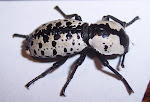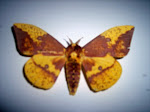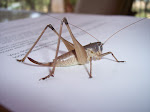Issue 5 - August 9, 2009 Mexican Free-tailed Bats
I was on the shore of the Guadalupe River late last evening, at my favorite fishing hole just across the road from Mark and Lacey’s, and my cell phone startles me with a noise halfway between a drum roll and a flamenco dance. I leaned my fishing pole up against a stump and finally located the pocket that was buzzing. It was too dark to see the screen so I gave the caller my best South Texan “Hurllo?”. (I always lower my voice and get a southern accent when I am hunting and fishing.)
To my surprise, it was my neighbor Lisa Hooker and she was all excited. “Clay, I’ve got something here that might interest you! You might even want to do one of your nature write-ups on THEM.” THEM turned out to be a group of Mexican Free-tailed Bats who decided to take up residence, on the residence, of Doug and Lisa down at the end of Pacific Place. I’m fascinated about all of our creatures here in Mystic Shores and this one was WAY too good to pass up.
First order of business was for me to go see the bats. It was already dark and the bats were all out of their roost by the time I got back up the hill to my home, so I decided to go down first thing this morning and scope it out. Even though bats return to their roost at the crack of dawn, there was NO WAY I was going down to the Hooker’s place early and sneak around their yard in the dark. I’ve seen Lisa shoot.
So, with my morning coffee still warm inside me and the sun up just a little, I went to the cul-de-sac in front of the Hooker’s home and immediately spotted a number of the bats returning from the night’s hunt. They homed in from all points of the compass but once they got near the house, they entered a clockwise flight pattern and started swarming in a tight little funnel about twenty feet in diameter. For all the world it looked like a little black tornado funnel. After a couple of minutes, they individually peeled off to land on the limestone wall and then crawl to roost behind the second floor shutters. There were a few hundred of them swirling around at the time and it was just amazing how they avoided a mid-air collision with one another. It is also noisy in a bat roost, at least at that time of the day, with half of them chirping and chittering away. The following picture doesn’t do the scene justice but it does show a dozen of them flying around. Lisa estimated that there were about four hundred huddled behind the wooden shutter.
(Kingdom; Animalia, Phylum; Chordata, Class; Mammalia, Order; Chiroptera, Family; Molossidae, Genus: Tadarida, Species: T. brasiliensis)
I researched these creatures a bit and learned a few things about the little darlings. Our Mexican Free-tailed Bats are not blind, don’t fly into your hair, attack babies or suck blood. They are more beneficial than harmful. They are also the official ‘flying mammal’ of Texas and are truly one of our great neighborhood creatures here at Mystic Shores.
Their common name is derived from the fact that they winter in Mexico (they are migratory) and that they have a unique tail which is not attached to their flight membrane for much of its length (see below). Apparently, the latter feature is unique to this species and makes it easy to distinguish them from other bats.
The Mexican Free-tailed Bat is a medium size, dark brown bat with a wingspan of about twelve inches and a body about three and a half inches long. They don’t weigh much (only 12.3 grams on average) and it takes about thirty five of them to total a pound. In addition to their prominent tail, they have large, forward facing, wide-spread ears that aid in their ‘eco-location’ of prey. This is their high frequency sonar-like capability that they use when flying around to detect and locate other objects.
They are nocturnal feeders and eat only flying insects, mostly small moths and mosquitoes. Our local bats feed on migrating cotton bollworm moths when available, a severe agricultural pest. They consume immense numbers of insects and it is estimated that a single large colony near San Antonio nightly consumes seventy five tons of insects. That is a lot of bugs.
A couple of comments about their flight abilities are appropriate, because these creatures are outstanding flyers. The wings are actually membranes spread between ‘fingers’ of their ‘hands’. They are agile beyond belief and can catch, on the fly, about 1000 mosquitoes in an hour. That is one mosquito every three to four seconds! They are also fast flyers and leave the roost at about 35mph, and have been clocked as high as 60mph with a favorable wind. The Mexican Free-tailed Bat flies pretty much straight to their feeding grounds and, in large colonies, it looks like a river of bats moving through the darkening sky. They can also fly to high altitudes and have been recorded up to 10,000 feet high. That’s almost two miles straight up!
In May of each year, our bats migrate up from Mexico and, shortly after arriving, the females have one pup each. The pups in a colony are mostly born over a very brief period and reportedly three quarters of the births are within a five day window. The pups are left together while the mothers are out hunting for food. The mothers only move their babies if the roost is disturbed or if the colony relocates. The mother bats return to nurse their pups several times a night. This daily feeding continues for about five weeks.
The way mother bats find their own offspring in a roost of tens of thousands (or even hundreds of thousands) of baby bats all the same age is a subject of much study. As many as 500 baby bats are crammed into a square foot of space in the ‘nursery’, which keeps them cozy and warm. Apparently, the unique ‘cry’ and smell of each baby bat can be recognized by their mother. That is truly amazing.
After they are weaned, young bats take their first flight. From that point on, they are pretty much on their own. In captivity, Mexican Free-tailed Bats have lived up to 18 years.
The Mexican Free-tailed Bats are numerous and widespread. They can be found throughout the southwest US from Texas through California and further south through Mexico, Central America and all the way through Brazil to the middle of South America. They are one of the most numerous mammals in this hemisphere.
Often they are concentrated in large cave complexes. I saw many of them a few years back when I visited Carlsbad Cavern near El Paso and more recently watched the flight displays in Austin (Congress Avenue Bridge) and near Fredericksburg, Texas. There are upwards of two million of these bats living in one cave south of us near Monterrey, Mexico, and as many as twenty million (!) at Bracken Cave (which is on private land) just a few miles down the road from us toward San Antonio. The larger colonies are often nursery colonies where the females bear and raise their young. Most of the males roost in other, but nearby, caves.
Such concentrations of life must leave a footprint, and with bat colonies they leave their ‘guano’. Bat poop builds up over the years and has been mined for fertilizer in many areas. Our Mexican Free-tailed Bats even contributed to the cause during the War of Northern Aggression. In 1863, a gun powder factory was built in Texas that got a key ingredient, saltpeter, from bat guano.
Caves are not the only place where Mexican Free-tailed Bats will live. They often shelter up in protected places like mines, tunnels, hollow trees and under bridges. It also looks like they will try to set up shop on houses behind shutters here in Mystic Shores, if they feel safe from predators and are near water, which is where their preferred food source is concentrated. This brings us back to the Hooker’s dilemma, because as eco-friendly as Doug and Lisa are, the guano will eventually become a problem and the infestation needs to be addressed.
Doug and Lisa have many options to get rid of the bats (killing them outright is distasteful and may not even be legal). The most direct way of getting them to move on is just to plug up access to the nooks and crannies that they require to roost. Stuffing fiberglass insulation around the perimeter of the shutters is reportedly one of the most effective ways to discourage them. Of course, this method needs to be finished after dusk and after the bats are gone for the night. (Also, there is an element of safety to this alternative because of the size and height of their home.) However, the Hooker’s are considering an even better alternative and that is to build a “bat house”!
A bat house can be constructed (free plans are available on-line) that might give the bats an even better alternative to our attics or behind shutters on our houses. The bats prefer dark, confined spaces where they can hang vertically without risk from predators. The ideal bat house looks like a flattened birdhouse, with access slots on the bottom, mounted on a pole away from trees and other structures. This is not too unlike the ones we put up to encourage swallows to nest. Bat Conservation International is a group that can also provide additional information and assistance to design a bat house that will give the desired results. It looks like the Hooker’s might have hit on a solution that will allow them to enjoy the benefits of having the bats around while eliminating the problem. How cool is that?
Clay
Click on these pictures to go directly to the article.
Followers
Blog Archive
About Me

- Clay Crum
- I'm always looking for suggestions (or photos) about other Mystic Shore wildlife. Do you know where a rattlesnake den is located? Do you have pictures of a mountain lion taken locally? Have you had interesting encounters with our wildlife? Share them with me by sending me an email or commenting on this blog.














